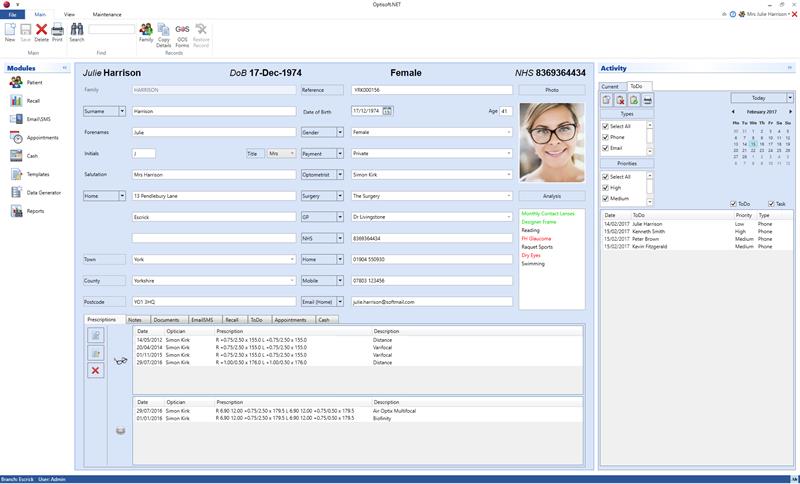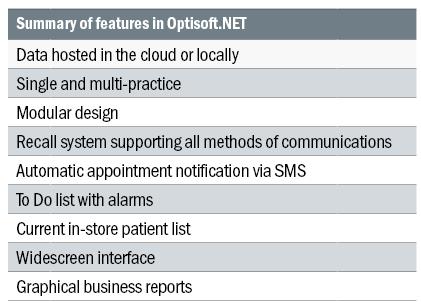Optisoft: Evolution of a system
Posted on 2 May 2024
Written by Make Hale for Optician.
Due the exponential expansion of technology into every facet of human existence, it can be easy to forget that the user friendly world of smartphones, tablets and apps is a relatively recent development. Those who cut their teeth in the formative years of computing will recall, probably with some affection, the more challenging world of DOS, boot disks and, with the benefit of hindsight, almost unlimited opportunities.
In the world of optics the past decades have seen practice management software (PMS) become ubiquitous. Founded in 1989, Optisoft was one of the first providers to be established and its commitment to keep pace with the cutting-edge technology has kept it at the forefront of the market since. Optisoft.NET, the fourth and latest iteration, was launched at the end of January.
‘Optisoft.NET isn’t an upgrade, it is a complete rewrite and the culmination of almost 30 years of software development experience dedicated to the market,’ says Keith Sheers, managing director and owner of Optisoft.
Going back to the generative stage in the history of Optisoft, Sheers had completed a degree in psychology before choosing to pursue his lifelong passion for computers.
‘My professional life as a computer salesman started a little before the IBM PC was launched in 1981. I had grown up on computers but studied psychology because I was interested in people too. I worked for a company specialising in auditing software for accountants and I saw how they had made a success of that vertical market.’
In 1988 Sheers’ brother Ronnie, who is an optometrist, asked him to review the existing PMS and make a recommendation for practices that were looking to computerise.
‘I got persuaded to have a look at the market and recommend the best system,’ says Sheers. ‘In the event, although several had some merit, I didn’t feel able to recommend any of them. None ticked all the boxes and due diligence showed that some providers faced an uncertain future.’

The latest version of the software Optisoft.NET
Sheers had always planned on forming his own company at some point and discovering the optical PMS market prompted him to action.
‘I had always had it in mind to run my own company, it was something my dad encouraged me to think about,’ says Sheers. ‘I was a software salesman, my friend Simon Kirk had programming experience, and my brother added advisory knowledge of the optical market. Overall it seemed like this was a great chance. So, we designed and built the first version of Optisoft – called Optisoft for DOS – and the company was founded June 1, 1989.’
The dedicated-to-the-optical-market software was built using mainstream development languages and the new company aimed for an intuitive interface supplied with high quality business hardware.
‘It was essentially a simple recall system,’ says Sheers. ‘We tried to make the system as simple as possible. We wanted to make it accessible and easy for owners to set up and train practice staff to use.’

2008’s Enterprise Edition
The recall function proved very effective in practice, as Sheers notes ‘more people came back’, and Optisoft was up and running. The original version was ultimately replaced in 1998 by Optisoft for Windows, which moved the software away from DOS and in line with the more accessible Microsoft design, and then Optisoft Enterprise Edition was launched in 2008 with an emphasis on increasingly sophisticated recall options.
Now Optisoft.NET is being brought to the market and Sheers emphasises that it represents a huge step forward.
‘Our goal from the outset was to make the perfect system and, using the very latest Microsoft technology, I feel we have got close to that this time. It incorporates all that was good in our past systems, but it has been enhanced to take full advantage of the internet and to meet the changing needs of the modern practice and their patients. It can be deployed locally or hosted in the cloud and we have kept our modular design too. It accommodates single or multiple practices and it has been optimised for the latest hardware.

Optisoft for Windows from 1999
‘It has taken five years to develop, at a cost of almost £1m, and is only the fourth iteration of the software in the lifetime of the company. However, that is a major achievement, especially when you take into account the size of the market, the limited development resources available as a result and the fact that we are, as far as I know, the only company on their fourth generation.’
Optisoft.NET is optimised for the larger widescreen monitors commonly used today. The higher resolution means an activity panel has been added to provide a task list for the user and a current in-store list of patients. According to Sheers the addition of the task list means the system now caters for all forms of communications.
Asked to highlight the biggest change, Sheers identifies the move to a centralised system which can handle single and multiple practices,with different options for hosting, as most significant. ‘This is why we built this new system from scratch,’ he comments. ‘The flexibility is so important to our customers – some are keen to look after the data themselves while others want it taken care of.’
As Sheers mentions the system is sold on a modular basis so people can buy one part and then add others when ready. Again the key attraction of this approach is to offer flexibility, which is paramount in the independent sector and this allows the software to be sold in its entirety to some practices and partially to others.

The original Optisoft for DOS from 1989 which is still in use in some practices
‘The software has always been for independents,’ says Sheers. ‘Today we have roughly 1,000 sites across the UK and Ireland, which gives us a significant share of the PMS market in the independent sector. Years ago we had some dealings with multiples but it was not a good fit. Ultimately we had to make a choice because the systems required for independents and multiples are different. Independents like to customise to suit individual situations whereas multiples want things locked down.’
The .NET product marks a departure for Optisoft as it sees the company adopting a subscription business model.

‘The software market is changing and moving to the subscription model,’ explains Sheers. ‘In the past we sold our product and offered a support contract that included updated versions of the software. With this we are moving to a subscription model which will secure our ability to serve our customers into the future – all future updates and services are included so there is no support contract.’
Sheers credits the evolution of the Optisoft’s PMS to both his dedicated team of 18 employees and the willingness of his clients to give feedback.
‘The expertise of customers feeds into it,’ he says. ‘We receive a steady stream of suggestions detailing what they want and over the years we’ve worked on it together to cover every aspect of practice life. Looking back, the software has been on quite a journey to get to the point it is today.
‘However, I’m also proud that there’s a handful of practices out there using the original Optisoft for DOS even now. It shows the quality and reliability that we are known for.’










